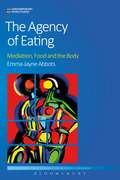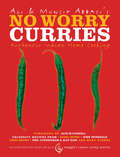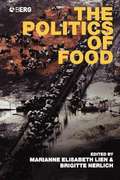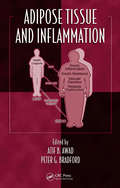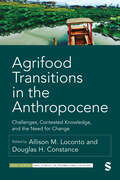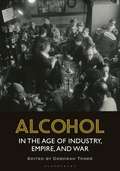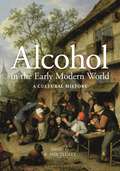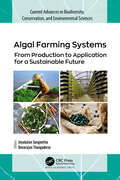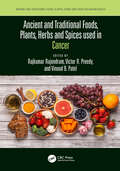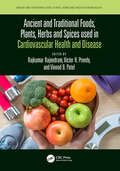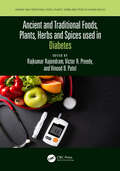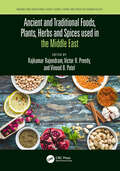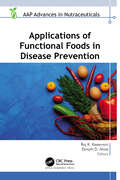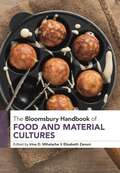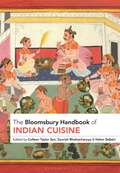- Table View
- List View
The Agency of Eating: Mediation, Food and the Body (Contemporary Food Studies: Economy, Culture and Politics)
by Emma-Jayne AbbotsDeciding what to eat and how to eat it are two of the most basic acts of everyday life. Yet every choice also implies a value judgement: 'good' foods versus 'bad', 'proper' and 'improper' ways of eating, and 'healthy' and 'unhealthy' bodies. These food decisions are influenced by a range of social, political and economic bioauthorities, and mediated through the individual 'eating body'. This book is unique in the cultural politics of food in its exploration of a range of such bioauthorities and in its examination of the interplay between them and the individual eating body. No matter whether they are accepted or resisted, our eating practices and preferences are shaped by, and shape, these agencies. Abbots places the body, materiality and the non-human at the heart of her analysis, interrogating not only how the individual's embodied eating practices incorporate and reject the bioauthorities of food, but also how such authorities are created by the individual act of eating. Drawing on ethnographic case studies from across the globe, The Agency of Eating provides an important analysis of the power dynamics at play in the contemporary food system and the ways in which agency is expressed and bounded. This book will be of great benefit to any with an interest in food studies, anthropology, sociology and human geography.
No Worry Curries: Authentic Indian Home Cooking
by Munsif AbbasiThis is a comprehensive home cookery Ebook for every type of Indian dish. The book is presented in 22 sections detailing techniques, equipment, ingredients and recipes. These include: the spice cabinet; starters and snacks; sauces; healthy options; vegetarian; seafood; curry in a hurry; oven dishes; barbecue cooking; stir frying; dishes containing alcohol; he best accompaniments; HOT curries; drinks; buffet dishes; rice dishes and basic sauces.
Politics Of Food (PDF)
by 9781859738535Is shopping for food really a political act? Why is it that, in a world with enough food for everyone, more people than ever go hungry? Why did the French resistance against genetically modified foods become a fight against McDonalds? Why did the foot-and-mouth epidemic in the UK become a problem for consumers? Capable of connecting human bodies to abstract nations, and techno-science to moral concerns, food has become one of the most contested fields of our time. It is high on the political agenda throughout the world. With disease, contamination, famine, hunger and imbalanced food markets all unfortunate realities, a book that interrogates the politics of food is long overdue. From the BSE outbreak in the 1990s through to cultural taboos and the genetic modification of produce and livestock, this timely book raises provocative questions about how we relate to food in the 21st century. Recent food scandals and genetically modified organism controversies have shattered the idea that 'food is food' as we have always known it, and exposed fundamental dilemmas related to risk and control. Taking as its starting point the premise that food is politicized in arenas not commonly thought of as political, The Politics of Food explores issues surrounding the development of global food markets in underdeveloped nations and addresses recent events that have had a profound impact on how consumers feel about what they eat. The epidemic of foot-and-mouth disease that swept through the UK in 2001 spawned a series of questions concerning the real costs of cheap food. What lessons have been learned? And how are food choices linked to the politics of food markets? With globalization, food has increasingly become entangled in webs of political significance. Through ethnographic case studies, this book reveals how food has come to serve a key role in political resistance, grassroots activism and nation-building. Anyone interested in globalization, food safety, or what food choices say about food politics will find this book essential reading.
Adipose Tissue and Inflammation
The American Obesity Association identifies obesity's link to numerous medical conditions, including hypertension, type 2 diabetes, cardiovascular disease, several cancers, and a host of inflammatory disorders. Evidence indicates that inflammation has more than a corollary relation with obesity; that in fact, obesity itself manifests a low-grade, m
Agrifood Transitions in the Anthropocene: Challenges, Contested Knowledge, and the Need for Change (SAGE Studies in International Sociology)
The greatest challenges of the twenty-first century stem from the fact that we are now living in a new epoch: the Anthropocene. The human footprint on the planet can no longer be denied. One of the greatest and most essential human innovations, agriculture, is being increasingly recognised as a leading contributor to climate change. According to global governance bodies, the world will need to feed a predicted nine billion people by 2050. However, in this Anthropocene, we must address the environmental inequalities in how these people will be fed. This book explores our current societal struggles to transition towards more sustainable agrifood systems. It suggests that debates around sustainable agriculture must be social as well as technical, exploring the growth of social movements campaigning for more democratic food systems. However, as each chapter demonstrates, both the problems and the solutions in sustainable agriculture are highly contested. Using the term ′agrifood′ to capture the nexus between research, governance and the environment knowledge-environment-governance, this book provides an in-depth and wide-ranging account of current research around agricultural production and food consumption. The book introduces the Anthropocene along with the fundamental question that it poses about human-nature interactions. It outlines the core concerns related to agriculture and food and the debates around the need for agrifood system transitions. Each chapter investigates controversies in the field through case studies. These contributions offer a call for sociologists of agriculture and food to engage with the controversies unfolding in the Anthropocene.
Alcohol in the Age of Industry, Empire, and War
This book examines alcohol production, consumption, regulation, and commerce, alongside the gendered, medical, religious, ideological, and cultural practices that surrounded alcohol from 1850 to 1950. Through analyzing major changes in alcohol's place in society, contributors demonstrate the important connections between industrialization, empire-building, and the growth of the nation-state. They also identify the diverse actors and communities that built, contested, and resisted those processes around the world.Overall, this book proposes a new global framework that is vital to understanding how deeply alcohol was involved in central processes shaping the modern world. It shows how empires were partly built through alcohol, in both economic and ideological terms, yet alcohol production, trade, and consumption were also sites for anti-colonial resistance. Contributors also discuss how alcohol regulations and public health discourses increasingly revealed the intent and reach of state power to monitor and police citizens, as well as the legitimization of that power through nationalism.Illustrated with over 50 images, the book will be a valuable resource for students and researchers studying the history of alcohol, as well as the cultural history of the 19th and 20th centuries more broadly.
Alcohol in the Early Modern World: A Cultural History
This book examines how the profound religious, political, and intellectual shifts that characterize the early modern period in Europe are inextricably linked to cultural uses of alcohol in Europe and the Atlantic world. Combining recent work on the history of drink with innovative new research, the eight contributing scholars explore themes such as identity, consumerism, gender, politics, colonialism, religion, state-building, and more through the revealing lens of the pervasive drinking cultures of early modern peoples. Alcohol had a place at nearly every European table and a role in much of early modern experience, from building personal bonds via social and ritual drinking to fueling economies at both micro and macro levels. At the same time, drinking was also at the root of a host of personal tragedies, including domestic violence in the home and human trafficking across the Atlantic. Alcohol in the Early Modern World provides a fascinating re-examination of pre-modern beliefs about and experiences with intoxicating beverages.
Algal Farming Systems: From Production to Application for a Sustainable Future (Current Advances in Biodiversity, Conservation, and Environmental Sciences)
The farming and cultivation of algae can provide sustainable solutions for issues like food security-related problems, costly health-related products, sustainable fuels, and more. However, the use of algae is currently restricted to high-value, low-volume markets, mainly due to the high investment and production costs involved. In recent years, algaculture for food and fuel purposes has begun a transition from R&D and pilot-scale operations to commercial-scale systems. This new book presents the latest technological innovations in algae production, market status, and prospects for algal applications.The book provides an informative overview of different perspectives on the commercial production of algae-based food, health, and high-value cosmeceutical products, providing an institutional framework to support and promote the development and commercialization of algal farming. The book discusses phycotechnology and highlights the current trends and future scope of algal technology. It also presents new information on algal culture conditions and cultivation strategies, including a look at geographic position and local climate as key factors in the implementation of microalgae-based processes. Algal production, marketing strategies, and their commercialization are discussed, as are the industrial applications of algae, focusing mainly on nutraceutical, pharmaceutical, and cosmeceutical applications of microalgae and macroalgae.
Ancient and Traditional Foods, Plants, Herbs and Spices used in Cancer (Ancient and Traditional Foods, Plants, Herbs and Spices in Human Health)
The use of different foods, herbs, and spices to treat or prevent disease has been recorded for thousands of years. Egyptian papyrus, hieroglyphics and ancient texts from the Middle East have described the cultivation and preparations of herbs and botanicals to “cure the sick.” There are even older records from China and India. Some ancient scripts describe the use of medicinal plants which have never been seen within European cultures. Indeed, all ancient civilizations have pictorial records of different foods, herbs, and spices being used for medical purposes. However, there are fundamental questions pertaining to the scientific evidence for the use of these agents or their extracts in modern medicine. There have been considerable advances in scientific techniques over the last few decades. These have been used to examine the composition and applications of traditional cures. Modern science has also seen the investigation of herbs, spices and botanicals beyond their traditional usage. For example, plants which have been used for “digestion” or “medical ills” since time immemorial are now being investigated for anti-cancer properties or their toxicity, using high throughput screening. Techniques also include molecular biology, cellular biochemistry, physiology, endocrinology and even medical imaging. However, much of the material relating to the scientific basis or applications of traditional foods, herbs, spices and botanicals is scattered among various sources. The widespread applicability of foods or botanicals is rarely described and cautionary notes on toxicity are often ignored. These questions are explored in Ancient and Traditional Foods, Plants, Herbs and Spices used in Cancer. Features · Provides an evidenced-based approach in describing usage and applications of traditional foods and botanicals in prevention and treatment of cancer · Contains chapters on biomedical research related to cancer studies · Discusses extraction and analysis of active agents, in vitro studies, pre-clinical investigations in animals, and clinical studies · Bridges modern day sciences with historical backgrounds related to foods and plants With contributions from leading international experts including those from world renowned institutions, this book is a reference for oncologists, physicians, health scientists, healthcare workers, pharmacologists, and research scientists.
Ancient and Traditional Foods, Plants, Herbs and Spices used in Cardiovascular Health and Disease (Ancient and Traditional Foods, Plants, Herbs and Spices in Human Health)
The use of different foods, herbs, and spices to treat or prevent disease has been recorded for thousands of years. Egyptian papyrus, hieroglyphics and ancient texts from the Middle East have described the cultivation and preparations of herbs and botanicals to "cure the sick". There are even older records from China and India. Some ancient scripts describe the use of medicinal plants which have never been seen within European cultures. Indeed, all ancient civilizations have pictorial records of different foods, herbs, and spices being used for medical purposes. However, there are fundamental issues pertaining to the scientific evidence for the use of these agents or their extracts in modern medicine. There have been considerable advances in scientific techniques over the last few decades. These have been used to examine the composition and applications of traditional cures. Modern science has also seen the investigation of herbs, spices and botanicals beyond their traditional usage. For example, plants which have been used for “digestion” or “medical ills” since time immemorial are now being investigated for anti-cancer properties or their toxicity, using high throughput screening. Techniques also include molecular biology, cellular biochemistry, physiology, endocrinology and even medical imaging. However, much of the material relating to the scientific basis or applications of traditional foods, herbs, spices and botanicals is scattered among various sources. The widespread applicability of foods or botanicals are rarely described and cautionary notes on toxicity are often ignored. These issues are explored in Ancient and Traditional Foods, Plants, Herbs and Spices used in Cardiovascular Health and Disease. Features: Investigates alternative healthcare paradigms that use traditional dietary foods, plant-derived materials, and extracts to treat cardiovascular diseases Provides information on diets, specific agents, and extracts Many chapters focus on plant-derived material, providing a historical background, uses, toxicity and cautionary notes and summary points With contributions from leading international experts, this book is useful for cardiologists, nutritionists, physicians, healthcare workers, food scientists and those working in the food industry, pharmacologists, and research scientists.
Ancient and Traditional Foods, Plants, Herbs and Spices used in Diabetes (Ancient and Traditional Foods, Plants, Herbs and Spices in Human Health)
The use of different foods, herbs, and spices to treat or prevent disease has been recorded for thousands of years. Egyptian papyrus, hieroglyphics and ancient texts from the Middle East have described the cultivation and preparations of herbs and botanicals to “cure the sick.” There are even older records from China and India. Some ancient scripts describe the use of medicinal plants which have never been seen within European cultures. Indeed, all ancient civilizations have pictorial records of different foods, herbs, and spices being used for medical purposes. However, there are fundamental issues pertaining to the scientific evidence for the use of these agents or their extracts in modern medicine. These issues are explored in Ancient and Traditional Foods, Plants, Herbs and Spices Used in Diabetes. Features · Investigates alternative healthcare paradigms that use traditional dietary foods, plant-derived materials, and extracts to treat diabetes · Describes scientific studies using modern day biomedical techniques · Provides information on diets, specific agents, extracts and resources. · Many chapters focus on plant-derived material, providing a historical background, uses, toxicity, and cautionary notes and summary points. There have been considerable advances in scientific techniques over the last few decades. These have been used to examine the composition and applications of traditional cures. Modern science has also seen the investigation of herbs, spices and botanicals beyond their traditional usage. Diabetes is one of the most common diseases worldwide, with over 400 million people with the illness. With chapter contributions by an international panel of contributors, this book is useful for researchers in the area of functional foods. Diabetologists, nutritionists, endocrinologists, healthcare workers, and pharmacologists will also find this book extremely valuable.
Ancient and Traditional Foods, Plants, Herbs and Spices used in the Middle East (Ancient and Traditional Foods, Plants, Herbs and Spices in Human Health)
The use of different foods, herbs, and spices to treat or prevent disease has been recorded for thousands of years. Egyptian papyrus, hieroglyphics and ancient texts from the Middle East have described the cultivation and preparations of herbs and botanicals to “cure the sick.” There are even older records from China and India. Some ancient scripts describe the use of medicinal plants which have never been seen within European cultures. Indeed, all ancient civilizations have pictorial records of different foods, herbs, and spices being used for medical purposes. However, there are fundamental questions and issues pertaining to the scientific evidence for the use of these agents or their extracts in modern medicine. These issues are explored in Ancient and Traditional Foods, Plants, Herbs and Spices used in the Middle East. Features · Describes uses and applications of plant-based materials from different countries of the Middle East. · Each chapter has unique cross references to foods, herbs, spices and botanicals · Bridges molecular biology, physiology and medical sciences · Coverage includes herbal medicines, supplements, lifestyle patterns, nutrition, and plant-based diets · Each chapter describes usage and applications of traditional foods and botanicals; historical background; toxicity; cautionary notes; and summary points There have been considerable advances in scientific techniques over the last few decades. These have been used to examine the composition and applications of traditional cures. Modern science has also seen the investigation of herbs, spices and botanicals beyond their traditional usage. Written by international experts, this is an essential read for food researchers, food scientists, and nutritionists, researchers and health professionals with an interest in the potential therapeutic value of Middle Eastern food components. The book will also be of relevance to physicians and pharmacologists.
Applications of Functional Foods in Disease Prevention (AAP Advances in Nutraceuticals)
Functional food sources are growing in popularity because they are exceptionally nutritious and provide amazing medical advantages. They can help ensure against infection, prevent supplement deficiency, and advance appropriate health development and improvement. With illustrative case studies, this new volume explores the many roles of functional foods in the prevention and management of various diseases, including diabetes, autism spectrum disorder, weight loss and obesity, microbial infections, ulcers and other gastrointestinal diseases, mental disorders and brain health, cardiac health and cardiovascular diseases, osteoporosis and bone health, and more.
Bell pepper (Cross-section) (Large Print)
This is a labelled image of a bell pepper in longitudinal cross section (cut through from top to bottom). There is a locator dot shown, which will be at the top left of the page when the image is the correct way up. The image of the bell pepper is in the middle of the page. At its centre is the fruits core covered by seeds. Around the core is a void, and around this, on the outside of the fruit, are its flesh and skin. At the top of the image is the peppers stem. The pepper is about ten centimetres long and although bright green when immature, can be be red, yellow or even orange when fully ripened.
Bell pepper (Cross-section) (UEB Contracted)
This is a labelled image of a bell pepper in longitudinal cross section (cut through from top to bottom). There is a locator dot shown, which will be at the top left of the page when the image is the correct way up. The image of the bell pepper is in the middle of the page. At its centre is the fruits core covered by seeds. Around the core is a void, and around this, on the outside of the fruit, are its flesh and skin. At the top of the image is the peppers stem. The pepper is about ten centimetres long and although bright green when immature, can be be red, yellow or even orange when fully ripened.
Bell pepper (Cross-section) (UEB Uncontracted)
This is a labelled image of a bell pepper in longitudinal cross section (cut through from top to bottom). There is a locator dot shown, which will be at the top left of the page when the image is the correct way up. The image of the bell pepper is in the middle of the page. At its centre is the fruits core covered by seeds. Around the core is a void, and around this, on the outside of the fruit, are its flesh and skin. At the top of the image is the peppers stem. The pepper is about ten centimetres long and although bright green when immature, can be be red, yellow or even orange when fully ripened.
Bioactive Compounds and Nutraceuticals from Dairy, Marine, and Nonconventional Sources: Extraction Technology, Analytical Techniques, and Potential Health Prospects
This new volume begins with an overview of bioactive compounds and nutraceuticals along with explanations of their chemical characteristics, profile, and physicochemical aspects. The volume discusses the extraction technologies of active ingredients and the analytical techniques of qualitative and qualitative analysis along with the profiling of functional compounds and nutraceuticals. The volume gives detailed descriptions of the techniques for extraction, isolation, and characterization of active ingredients from food preparations.The volume also discusses important bioactive compounds and nutraceuticals specifically from milk and dairy products as well as from marine algae and seaweeds. From there, the volume explores bioactive compounds and nutraceuticals from nonconventional sources, such as from spices and condiments, and from microbial sources.This volume is the companion volume to the book Bioactive Compounds and Nutraceuticals from Plant Sources: Extraction Technology, Analytical Techniques, and Potential Health Prospects by the same editors.
The Bloomsbury Handbook of Food and Material Cultures
Cookbooks. Menus. Ingredients. Dishes. Pots. Kitchens. Markets. Museum exhibitions. These objects, representations, and environments are part of what the volume calls the material cultures of food. The book features leading scholars, professionals, and chefs who apply a material cultural perspective to consider two relatively unexplored questions: 1) What is the material culture of food? and 2) How are frameworks, concepts, and methods of material culture used in scholarly research and professional practice? This book acknowledges that materiality is historically and culturally specific (local), but also global, as food both transcends and collapses geographical and ideological borders. Contributors capture the malleability of food, its material environments and “stuff,” and its representations in media, museums, and marketing, while following food through cycles of production, circulation, and consumption. As many of the featured authors explore, food and its many material and immaterial manifestations not only reflect social issues, but also actively produce, preserve, and disrupt identities, communities, economic systems, and everyday social practices. The volume includes contributions from and interviews with a dynamic group of scholars, museum and information professionals, and chefs who represent diverse disciplines, such as communication studies, anthropology, history, American studies, folklore, and food studies.
The Bloomsbury Handbook of Indian Cuisine
This reference work covers the cuisine and foodways of India in all their diversity and complexity, including regions, personalities, street foods, communities and topics that have been often neglected. The book starts with an overview essay situating the Great Indian Table in relation to its geography, history and agriculture, followed by alphabetically organized entries. The entries, which are between 150 and 1,500 words long, combine facts with history, anecdotes, and legends. They are supplemented by longer entries on key topics such as regional cuisines, spice mixtures, food and medicine, rites of passages, cooking methods, rice, sweets, tea, drinks (alcoholic and soft) and the Indian diaspora. This comprehensive volume illuminates contemporary Indian cooking and cuisine in tradition and practice.
Burger (Large Print)
This is a picture of a burger seen from the side in the middle of the page. There is a locator dot shown, which will be at the top left of the page when the image is the correct way up. At the top of the picture is half of the burger bun. Going down the page from this is a slice of tomato, burger meat, a lettuce leaf, more burger meat, and lastly the other half of the bun. On the left hand side of the burger, near the bottom is a dollop of tomato ketchup dripping down.
Burger (UEB Contracted)
This is a picture of a burger seen from the side in the middle of the page. There is a locator dot shown, which will be at the top left of the page when the image is the correct way up. At the top of the picture is half of the burger bun. Going down the page from this is a slice of tomato, burger meat, a lettuce leaf, more burger meat, and lastly the other half of the bun. On the left hand side of the burger, near the bottom is a dollop of tomato ketchup dripping down.
Burger (UEB Uncontracted)
This is a picture of a burger seen from the side in the middle of the page. There is a locator dot shown, which will be at the top left of the page when the image is the correct way up. At the top of the picture is half of the burger bun. Going down the page from this is a slice of tomato, burger meat, a lettuce leaf, more burger meat, and lastly the other half of the bun. On the left hand side of the burger, near the bottom is a dollop of tomato ketchup dripping down.
Cacao fruit (Cross-section) (Large Print)
This is a labelled image of a cacao fruit in longitudinal cross section (cut through from top to bottom). This fruit is the source of cocoa beans, from which chocolate products are made. There is a locator dot shown, which will be at the top left of the page when the image is the correct way up. The image of the cacao fruit is in the middle of the page. At its centre is a cavity filled with white pulp and cocoa beans (seeds), which are also white and light brown, and only change to their familiar very dark brown colour after processing. The hard, leathery rind or skin is ridged and is up to three centimetres thick. The fruit is between fifteen and thirty centimetres long.
Cacao fruit (Cross-section) (UEB Contracted)
This is a labelled image of a cacao fruit in longitudinal cross section (cut through from top to bottom). This fruit is the source of cocoa beans, from which chocolate products are made. There is a locator dot shown, which will be at the top left of the page when the image is the correct way up. The image of the cacao fruit is in the middle of the page. At its centre is a cavity filled with white pulp and cocoa beans (seeds), which are also white and light brown, and only change to their familiar very dark brown colour after processing. The hard, leathery rind or skin is ridged and is up to three centimetres thick. The fruit is between fifteen and thirty centimetres long.
Cacao fruit (Cross-section) (UEB Uncontracted)
This is a labelled image of a cacao fruit in longitudinal cross section (cut through from top to bottom). This fruit is the source of cocoa beans, from which chocolate products are made. There is a locator dot shown, which will be at the top left of the page when the image is the correct way up. The image of the cacao fruit is in the middle of the page. At its centre is a cavity filled with white pulp and cocoa beans (seeds), which are also white and light brown, and only change to their familiar very dark brown colour after processing. The hard, leathery rind or skin is ridged and is up to three centimetres thick. The fruit is between fifteen and thirty centimetres long.
